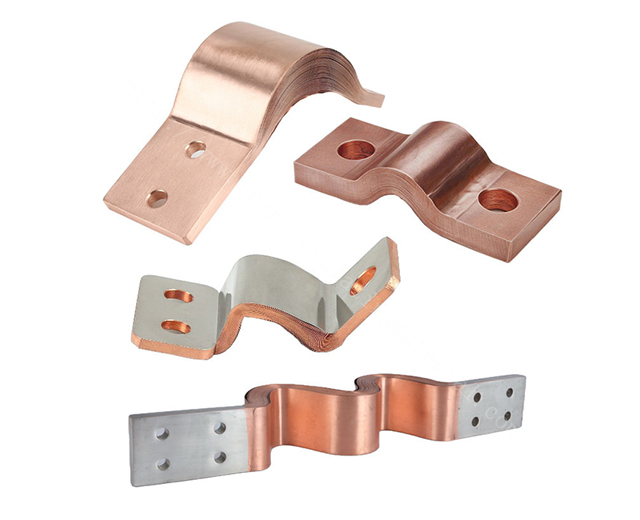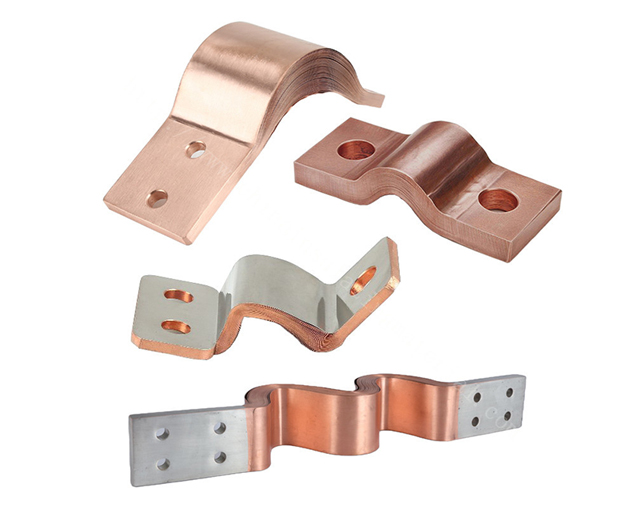

Copper laminated Flexible Busbars are advanced electrical conductors composed of multiple thin copper layers (typically 0.1mm to 0.5mm thick) bonded together with insulating materials. This laminated construction combines copper’s excellent electrical conductivity (approximately 58 MS/m at 20°C) with outstanding mechanical flexibility, allowing bending radii as low as 10 times the busbar thickness without damage.
Thanks to this unique layered design, these busbars deliver high current capacities ranging from 100A to 5000A and current densities up to 10A/mm². They maintain temperature rises below 50°C under normal operating conditions, ensuring efficient and safe power transmission in compact, flexible configurations.

The manufacturing process of copper Laminated Flexible Busbars involves:
Copper Foil Lamination: Thin copper foils are precisely stacked and laminated under heat and pressure to form multi-layered sheets.
Insulation Bonding: Each copper layer is separated by an insulating material to prevent short circuits and ensure electrical isolation.
Cutting and Forming: Laminated sheets are cut to the desired dimensions and shaped into busbars using bending and forming techniques optimized for flexibility.
Surface Treatment: Edges and terminations are tin or silver plated to improve corrosion resistance and solderability.
Testing and Quality Control: Each busbar undergoes rigorous electrical and mechanical tests, including conductivity measurements, insulation resistance, flex endurance, and thermal performance assessments.
Copper BusBar Insulated find critical applications across diverse industries, including:
Electric Vehicles (EV) and Hybrid Systems: Used in battery packs to connect modules with ultra-low contact resistance (<10>
Renewable Energy Systems: Solar inverters utilize these busbars for DC connections rated up to 1000V, managing high di/dt switching currents and reducing electromagnetic interference by 20–30 dB.
Industrial Power Distribution: Employed in switchgear and motor control centers, capable of withstanding short-circuit currents up to 100kA for 1 second and operating continuously at temperatures up to 105°C.
Aerospace and Defense: Critical in avionics for weight savings (40–60% lighter than traditional wiring) while meeting stringent shock and vibration standards (MIL-STD-810).
Data Centers: Facilitate high-current 48V DC busways with current densities of up to 8A/mm², minimizing voltage drop over long cable runs.
Electrical Conductivity: ≥98% IACS with resistivity of 1.724 μΩ·cm at 20°C.
Current Capacity: Supports 2–3 times more current than equivalent round conductors due to enhanced surface area.
Thermal Performance: Copper’s high thermal conductivity (385 W/(m·K)) combined with heat dissipation up to 1.5 W/cm².
Mechanical Flexibility: Endures over 100,000 flex cycles at minimum bending radius with less than 5% resistance increase.
Voltage Rating: Typically designed for 600V to 1000V systems with insulation resistance above 1000 MΩ.
Weight Reduction: Up to 70% lighter than traditional rigid busbars with equivalent current capacity.
Corrosion Resistance: Tin or silver plating on contact areas enhances durability.
EMI Reduction: Laminated layers and shielding reduce electromagnetic interference in sensitive applications.
When designing Copper BusBar Insulated, consider:
Current Requirements: Calculate necessary cross-sectional area based on current densities up to 10A/mm².
Flexibility Needs: Ensure bending radius respects minimum 10× thickness to maintain integrity.
Voltage and Insulation: Select insulation materials rated for operating voltages (600V–1000V) with high dielectric strength.
Thermal Management: Account for heat dissipation requirements and temperature rise limits (<50°c).<>
Environmental Conditions: Include corrosion protection (plating), vibration resistance, and UV exposure if applicable.
Connection Interfaces: Design terminations with proper plating and torque specifications for reliable contact.
Compliance: Meet relevant standards such as UL, IEC, and MIL-STD where required.
For demanding environments like EV battery packs, aerospace, or renewable energy:
Optimize Layer Thickness: Balance flexibility and current capacity with laminated layer count.
Integrate EMI Shielding: Use laminated structures to reduce noise in sensitive electronics.
Enhance Vibration Resistance: Select silicone-based or high-durability insulating layers.
Design for Thermal Cycling: Ensure materials withstand repeated heating and cooling cycles without delamination.
Implement Quality Control: Include contact resistance testing and thermal imaging in production.
Customize Terminations: Tailor busbar ends for welding, bolting, or soldering depending on application.
Apply Protective Coatings: Use antioxidant compounds to extend lifespan in harsh environments.
G and N Fortune Limited offers premium Insulated Flexible Copper Bars with unmatched quality and service:
Tailored Solutions: Custom sizes, layer counts, and insulation materials to fit your project’s specific needs.
Advanced Manufacturing: State-of-the-art lamination and forming processes ensuring consistency and reliability.
Comprehensive Testing: Electrical, mechanical, and thermal testing guarantees product performance.
Global Certifications: Products compliant with UL, CE, RoHS, and MIL-STD standards.
Industry Expertise: Proven track record supplying to EV, renewable energy, aerospace, data center, and industrial sectors.
Competitive Lead Times: Efficient production and logistics to meet tight project schedules.
Technical Support: Dedicated engineering support for design optimization and troubleshooting.
Q1: What voltage ratings do your Insulated Flexible Copper Bars support?
A1: Our busbars are typically rated for 600V to 1000V systems with insulation resistance above 1000 MΩ, suitable for most industrial and automotive applications.
Q2: How flexible are these laminated busbars?
A2: They withstand over 100,000 flex cycles at a minimum bending radius of about 10 times the busbar thickness, maintaining electrical performance with less than 5% resistance increase.
Q3: What current capacities can these busbars handle?
A3: Current capacities range from 100A up to 5000A, with current densities reaching 10A/mm², outperforming equivalent round conductors.
Q4: Are these busbars suitable for EV battery packs?
A4: Yes, they are widely used in electric vehicles and hybrid systems for battery interconnections, providing low contact resistance (<10>
Q5: What materials and coatings are used?
A5: Copper layers are laminated with insulating materials; terminals are often tin or silver plated for corrosion resistance and reliable connectivity.
Q6: How do you ensure quality and safety?
A6: Products undergo strict testing, including electrical conductivity, insulation resistance, partial discharge, thermal cycling, and mechanical flex tests. They comply with UL, CE, RoHS, and MIL-STD standards.
Q7: Can these busbars reduce system weight?
A7: Yes, laminated flexible busbars can reduce system weight by up to 70% compared to traditional rigid busbar systems of the same current capacity.